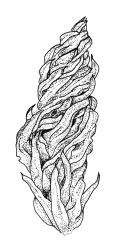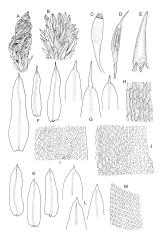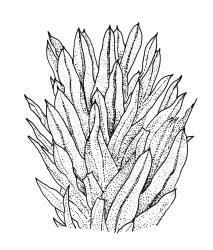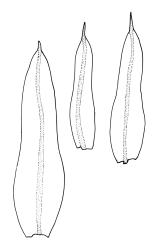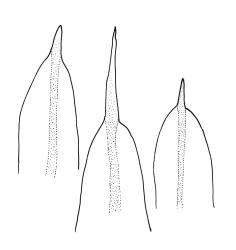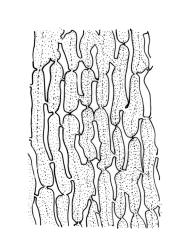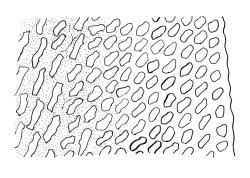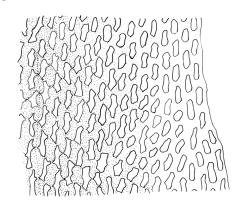- = Macromitrium hectorii Mitt. in Hooker, Handb. New Zealand Fl. 430 (1867) – as Hectori
Plants lustrous, forming dense cushions on bark or rock. Stems and rhizoids as per genus. Branches unbranched or branched by innovation, c. 4–10 mm. Branch leaves spirally twisted around branch when dry, erect-spreading when moist, oblong-lanceolate, acute or acuminate and cuspidate at apex, keeled, moderately rugose (best seen when moist), with a single plica of various length on each side of the costa, mostly 2.0–2.6 × 0.7 mm, KOH positive chestnut-red; margins entire, mostly narrowly recurved; upper laminal cells mostly oval to oblong, smooth, thick-walled, mostly 9–12 μm in greater diam., arranged in distinct oblique rows, those adjacent to costa mostly somewhat longer; marginal cells either slightly longer and oriented parallel to the margin or not differentiated, not forming a distinct border; cells of the lower lamina mostly elongate-rhomboid with ± curved walls, very thick-walled and distinctly porose, nearly smooth or weakly prorate on the abaxial surface; cells at basal margins not differentiated. Costa excurrent and filling an excurrent cusp of varying length, in lower leaf occupying c. 0.1 of the leaf width at base, and c. 40–50 μm wide near base, in cross-section as per genus.
Phyllodioicous. Perichaetia terminal (but often overtopped by innovations), with perichaetial leaves longer (to 3.5 mm) but not otherwise differentiated. Male plants dwarf, epiphyllous on ♀ plants, frequent, bearing 1 or more perigonia. Setae c. 6–8 mm, slender, straight or slightly curved; capsules cylindric, exserted and erect, strongly 8-ribbed, c. 2.0 mm; exothecial cells thick-walled, mostly short-oblong and c. 30–35 × 12–15 μm, not in clearly differentiated vertical ranks; stomata numerous in c. lower ⅓ of urn (apparently absent from neck), superficial; annulus as per genus; operculum with a very long and fine rostrum from a conic base, c. ⅔ the length of capsule. Peristome as per genus; exostome teeth 16, orange, ± reflexed when dry, with a distinct median line and coarse transverse or swirled striations on the outer surface; endostome segments less than ¼ the exostome teeth (or longer fide Vitt), coarsely vertically striate. Calyptra as per genus. Spores ± spherical, coarsely papillose, 30–36 μm diam.
NI: Wellington (Dalefield); SI: Westland (Ōtira), Otago (s.loc.), Southland (near Mores Bush Scenic Reserve); St (Mt Anglem, Half Moon Bay, Pryse’s Peak, Ulva I., Port Pegasus); C. Vitt (1989) recorded this species from three further localities in Southland.
Endemic.
Little information is available as to the substrate preferences of this predominantly epiphytic species. It is documented from Dracophyllum sp. (on Campbell I.), "Leptospermum", Weinmannia racemosa, as well as Dacrydium cupressinum; it also occurs on rock. On the Southland coast near Mores Bush, S. campbelliana occurred as isolated cushions among an extensive turf of Macromitrium longirostre on a conglomerate boulder at a site subject to salt spray. Vitt’s (1989, p. 286) suggestion that it is not salt tolerant conflicts with my own limited field observations.
Ranging from near sea level to c. 400 m (on Campbell I.) and to at least 300 m on Stewart I. (Mt Anglem). Holomitrium perichaetiale, Macromitrium longirostre, and M. retusum are frequent associates.
The record of this predominantly southern and/or subalpine species at Dalefield (a lowland site in the Wairarapa district) is perplexing. Vitt (1989, fig. 13) recorded it from one other locality in Wellington L.D. The Dalefield specimen (W. Martin 405.3, CHR 587979) has some prorate lower laminal cells and its upper marginal cells are not differentiated, but in all its branch leaves the costa is excurrent to form a distinct cusp.
When well-developed, the strongly twisted leaves of the dry branches, together with a distinctly excurrent costa forming an elongate cusp, give S. campbelliana a characteristic look. However, the length of the apical cusp is highly variable in this species. The nature of the basal laminal cells (usually smooth or weakly prorate, but often difficult to see under a compound microsocope) and the very slightly differentiated upper marginal cells are not reliable features. Collections from Mt Anglem (CHR 587978; WELT M004545) and Half Moon Bay (CHR 629620) have particularly short cusps and are ambiguous in respect of the laminal cell features. It seems best to accept these collections as somewhat aberrant S. campbelliana. Mixed collections of S. campbelliana and S. knightii occur and these can cause confusion.



